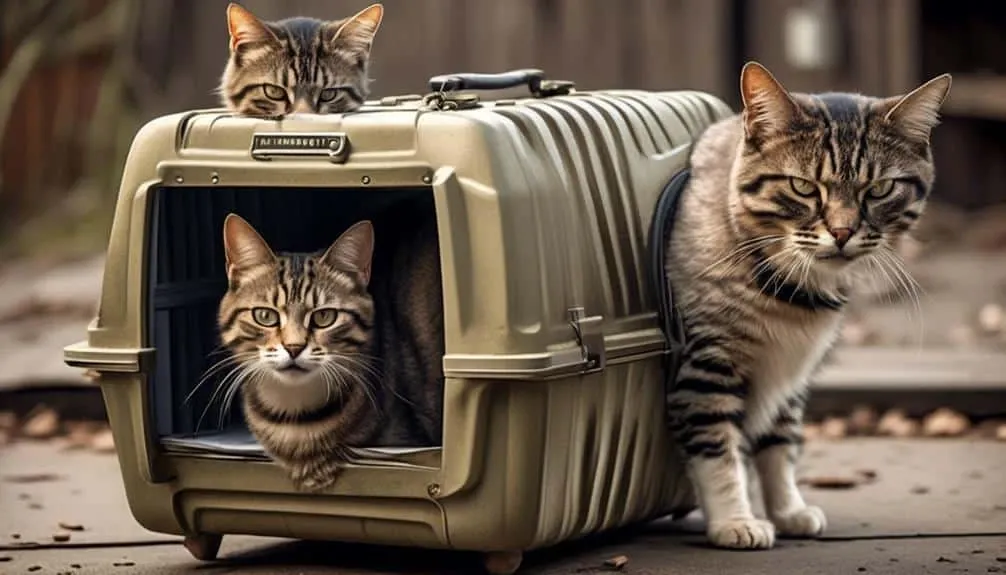The Best Fluffy Pancakes recipe you will fall in love with. Full of tips and tricks to help you make the best pancakes.

Have you ever wondered if traveling with two cats in one carrier is a recipe for disaster? It's a theory that many cat owners have pondered, and in this discussion, we will explore the potential risks and challenges of sharing a carrier with multiple feline companions.
Cats are known for their territorial nature, and being confined in a small space together can lead to a variety of issues. But is it really as disastrous as it seems?
Join us as we delve into the complexities of traveling with two cats in one carrier and uncover the truths behind this commonly debated topic.
Key Takeaways
- Sharing a carrier when traveling with two cats can lead to feline aggression.
- Most airlines do not allow multiple cats to fly in one carrier.
- Cats are territorial animals and may become stressed when traveling.
- Each cat should have their own carrier to minimize stress and potential aggression.
Feline Aggression During Shared Travel
Feline aggression during shared travel can pose risks to the safety and well-being of both cats involved. Cats are territorial animals, and when confined in a small space like a carrier, they may become stressed and exhibit aggressive behaviors. This can result in physical harm to both cats as well as distractions for the driver.
To ensure a positive travel experience, it's important to implement effective feline aggression management strategies and reduce stress during shared travel. One strategy is to provide each cat with their own carrier to minimize territorial conflicts. Additionally, acclimating cats to their carriers through positive reinforcement and short practice trips can help them adjust to the travel environment.
Airline Guidelines for Traveling With Cats
When it comes to traveling with cats, it's essential to familiarize yourself with the airline guidelines for transporting your feline companions.
Most airlines don't allow multiple cats to fly in one carrier. Each airline has clear guidelines on whether pets can travel in the same carrier. The IAT LAR regulations state the limit for transporting two live puppies or kittens. Traveling with two grown cats in one carrier isn't possible.
Different airlines may have different rules, so it's important to check with the specific airline before purchasing tickets.
It's generally recommended to keep cats in separate carriers to minimize stress and potential aggression. Each cat should have their own carrier that's small enough to fit under the seat in front of you.
Choosing the Right Carrier for Two Cats
Choosing the right carrier for two cats is crucial for ensuring their comfort and safety during travel. When selecting a carrier, there are several important considerations, including carrier size and introducing cats to carriers.
The carrier should be spacious enough to allow each cat to stand, turn around, and lie down comfortably. Measure your cats beforehand to ensure the carrier provides enough space for their needs. Additionally, consider any additional space required for food, water, and a litter box during long-distance trips.
Introducing cats to carriers is an essential step in preparing them for travel. Start by making the carrier appealing and using positive reinforcement, such as treats or toys, to create a positive association. Gradually increase the time the cats spend in the carrier and take short practice trips in the car to help them get used to the motion and sounds.
The Versatility of the One For Pets Carrier
The One For Pets carrier offers a versatile solution for traveling with two cats, providing options for both separate and shared spaces. Here are four reasons why the One For Pets carrier is a great choice for traveling with two cats in one carrier:
- Flexibility: The carrier can be used as two separate carriers for each cat, allowing them to have their own space and reducing the risk of territorial aggression.
- Shared Space: With the divider in the middle, the carrier can be attached together to create a shared space for the two cats. This option allows them to be close to each other while still providing some separation.
- Convenience: The carrier can also be used as one single carrier for both cats to share. This option is ideal for short trips or when space is limited.
- Testing Compatibility: The One For Pets carrier allows you to test the cats' willingness to travel together. If they get along well, you can use the carrier as a shared space. If they show signs of aggression or stress, you can easily separate them into their own individual carriers.
Traveling with two cats in one carrier has its pros and cons. With the versatility of the One For Pets carrier, you can customize the space to suit your cats' needs and minimize the risk of territorial tensions.
Creating a Positive Travel Experience by Car
To ensure a positive travel experience for your cats, it's essential to create a comfortable and secure environment within the car. Tips for reducing feline aggression during shared travel include:
- Acclimating your cats to their carriers before the trip. Start by introducing the carrier as a positive and comfortable space in their daily environment. Gradually increase the time they spend in the carrier, using treats or toys to create a positive association.
- Take short practice trips in the car with the cats in the carrier to help them get used to the motion and sounds. Provide familiar bedding or clothing with their scent to help them feel secure.
- Reward and praise calm behavior during carrier acclimation.
- Consulting with a veterinarian can provide advice on the best carrier options and calming techniques if necessary.
Individual Needs and Preferences of Cats
Understanding the individual needs and preferences of cats is crucial when it comes to ensuring their comfort and well-being during travel. Cats are unique creatures with distinct behaviors and requirements, and taking these into consideration can help alleviate traveling challenges.
Here are four key factors to keep in mind:
- Cat behavior: Cats are territorial animals, and sharing a carrier with another cat can lead to stress and aggression. Each cat should have its own carrier to minimize potential conflicts.
- Comfort and safety: Cats should have enough space in the carrier to stand, turn around, and lie down comfortably. The carrier should also provide proper ventilation and a secure locking mechanism.
- Acclimation: Introduce the carrier as a positive and comfortable space in the cat's daily environment. Gradually increase their time spent in the carrier, using treats and toys to create a positive association.
- Consultation with a veterinarian: Before traveling with cats, especially if they have health conditions or anxiety, it's important to seek guidance from a veterinarian. They can recommend appropriate carriers, provide calming techniques or medications if necessary, and offer advice on feeding, hydration, and bathroom breaks during travel.
Understanding and catering to the individual needs and preferences of cats can make their travel experience much more enjoyable and less stressful.
Proper Acclimation to Carriers
To ensure a smooth and stress-free travel experience for your cats, it's crucial to properly acclimate them to their carriers.
Proper carrier training involves a gradual introduction to travel, allowing your cats to become familiar and comfortable with their carriers. Start by making the carrier appealing to your cats by placing treats or toys inside. Allow them to explore the carrier at their own pace, rewarding calm behavior with praise and treats.
Gradually increase the time your cats spend in the carrier, starting with short practice trips in the car. This will help them get used to the motion and sounds of travel. Additionally, providing familiar bedding or clothing with their scent can help them feel secure in the carrier.
Remember to consult with a veterinarian for specific advice on carrier acclimation and any necessary calming techniques or medications.
Essential Features of a Cat Carrier
A cat carrier should have essential features that prioritize your cat's comfort, safety, and well-being during travel. Here are four important factors to consider when choosing the right carrier size, type, and design for your cats:
- Size:
Measure your cats to ensure the carrier provides enough space for them to stand, sit, lie, and turn around comfortably. A cramped carrier can cause stress and discomfort.
- Type:
Consider whether a soft-sided or hard-sided carrier is more suitable for your cats. Soft-sided carriers are lightweight and easier to store, while hard-sided carriers provide more protection.
- Ventilation:
Ensure proper ventilation in the carrier to allow for fresh air circulation. Good airflow helps prevent overheating and provides a comfortable environment for your cats.
- Comfort:
Look for a carrier with features that enhance your cats' comfort, such as a removable, washable bedding. Additionally, consider additional space for food, water, and a litter box during long-distance trips.
Importance of Separate Carriers for Safety and Comfort
Separate carriers for each cat are essential to ensure their individual safety and comfort during travel. Cats are territorial animals, and sharing a carrier can lead to stress, aggression, and potential harm. Gradually introducing the carrier to your cats is important to create a positive association.
Start by making the carrier appealing and using treats to entice them inside. Take short practice trips in the car to acclimate them to the traveling experience. Consulting with a veterinarian for travel advice is recommended, especially if your cats have any health conditions or anxiety. They can provide guidance on the best carrier options for your specific cats, as well as recommend calming techniques or medications if necessary.
Each cat having their own carrier allows for easier monitoring of their well-being during the journey and reduces the risk of territorial tensions.
Frequently Asked Questions
Can Two Cats Safely Share a Carrier During Car Travel?
No, it is not recommended to have two cats share a carrier during car travel. It is safer to have each cat in its own carrier to minimize stress and potential aggression.
What Are the Guidelines for Traveling With Multiple Cats on Airplanes?
When traveling with multiple cats on airplanes, it is important to prioritize their safety and comfort. Tips for reducing stress include using separate carriers, ensuring proper ventilation, and providing food, water, and a litter box.
How Do I Choose the Right Carrier for Two Cats?
When choosing a carrier for two cats, consider their comfort and size. Take into account airline requirements for separate carriers. This ensures their individual safety and reduces stress during travel.
Is the One for Pets Carrier Suitable for Traveling With Two Cats?
No, the One For Pets carrier is not suitable for traveling with two cats in one carrier. It's best to use separate carriers to minimize territorial tensions and ensure the comfort and safety of each cat.
How Can I Create a Positive Travel Experience for Multiple Cats When Traveling by Car?
To create a peaceful travel environment for multiple cats when traveling by car, use separate carriers to reduce stress. Gradually acclimate cats to their carriers through positive reinforcement and short practice trips. Consult with a veterinarian for guidance and ensure carriers are comfortable and secure.
Conclusion
In conclusion, when it comes to traveling with two cats, it's important to prioritize their safety and comfort. Sharing a carrier may lead to feline aggression and stress, which can be detrimental to their health. To ensure a positive travel experience, it's recommended to follow airline guidelines, choose the right carrier, and provide separate carriers for each cat.
Interestingly, according to a study by the American Veterinary Medical Association, 80% of cats exhibited signs of stress when traveling in a shared carrier. This highlights the importance of providing individual carriers for each cat. By doing so, you can minimize the risk of aggression and stress, and create a more comfortable environment for your feline companions.
Following airline guidelines is also crucial when traveling with cats. Different airlines have specific requirements for pet carriers, such as size, materials, and ventilation. Adhering to these guidelines will ensure that your cats are safe and that you have a hassle-free travel experience.
Choosing the right carrier is another important aspect to consider. Look for carriers that are sturdy, secure, and well-ventilated. It's also a good idea to choose carriers that have easy access points for feeding, cleaning, and comforting your cats during the journey.
In summary, traveling with two cats requires careful planning and consideration. Prioritizing their safety and comfort by providing separate carriers, following airline guidelines, and choosing the right carrier will help ensure a positive travel experience for both you and your feline companions.








